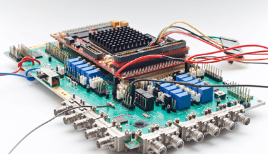Ultrawideband communication technology revived!
on

Imec (Belgium) and the Holst Centre (Netherlands) have announced a chip set for extremely low-power impulse radio ultrawideband (IR-UWB) technology. Operating in the 6–10 GHz band, the radio provides high-quality wireless communication capability for battery-operated mobile and sensing applications, with fade resilience and negligible interference.
The new chip set is designed to make UWB communication available to battery-operated devices for personal area networks and positioning sensors. Potential applications include short-range video streaming and near-body audio streaming, such from a smartphone to a headset. With the UWB radio used for wireless audio streaming, smartphone battery life can be increased by over three times compared to a conventional Bluetooth-based solution, while headphone battery life can be extended by more than five times. Unlike Bluetooth, UWB radio is immune to interference from other wireless devices operating in the same area and the same frequency band.
Impulse radio ultrawideband is especially suitable for short-range (20 m) communication and positioning sensors. The large bandwidth improves resilience to fading, resulting in superior communication reliability – especially compared to narrowband solutions, which are prone to signal loss in surroundings with reflective surfaces and multipath propagation. In addition, spreading information over a wide bandwidth decreases power spectral density, thereby reducing interference with other systems and lowering the probability of interception. IR-UWB is also suitable for positioning sensors, because reflection of the signal pulses allows object positioning with resolution in the centimetre range.
The chip set developed by Imec and the Holst Centre consists of a transmitter, a receiver front-end and a receiver digital baseband. The transmitter delivers 13 dBm peak power with an average power consumption of 3.3 mW. The receiver front-end has -88 dBm sensitivity at 1 Mbps. A digital synchronization algorithm enables real-time duty cycling to yield an average power consumption of 3 mW. A digitally controlled oscillator with 100 ppm frequency resolution and a baseband frequency tracking algorithm enable coherent reception. The radio achieves a 75 dB link budget at a data rate of 1 Mbps.
Image: Imec


Discussion (0 comments)